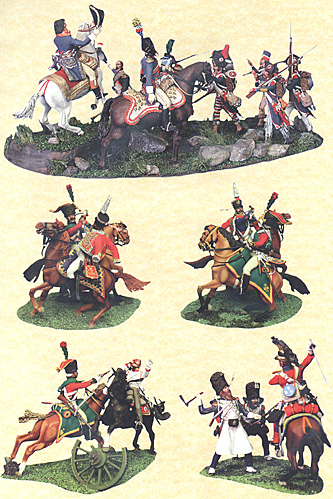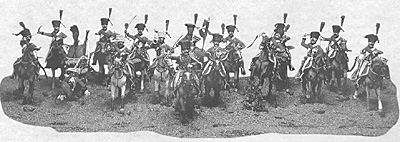 (Extracted from European Armies 1796-1815 Volume 1 by Valery Voloshyn)
(Extracted from European Armies 1796-1815 Volume 1 by Valery Voloshyn)
The Horse Guards or Cavalry Guards were the pride and joy of the Imperial Army. Recruit selection to them was particularly detailed. The best of the best cavalrymen who had the necessary characteristics were selected into its Corp: Length of service, combat experience and, something not without importance, the necessary phlysical requirements. In 1805 the Cavalry Guards consisted of a total of 2 regiments of horse grenadiers and horse chasseurs. In the horse chasseurs regiment there was included the Mameluke Company. The Horse Guards were commanded by Marshal Besser, who was head of all the Imperial Guards. The chasseurs regiment consisted of 5 squadrons, the fifth squadron constituting the Emperor's personal escort. Colonel Francois-Louis Morlan, aged 34, commanded the summer regiment. A part of the chasseurs was left in Vienna to defend the army headquarters.
In this way there were 580 cavalryrnen in 4 squadrons of the horse chasseurs regiment. The Mameluke company, according to the staking level, had 9 officers, 114 non commissioned officers and private soldiers. However, we can deduce that before Austerlitz it did not include more than 100 cavalrymen. Their commander was Captain Antoine Charles Bernard Deletre. The Company was made up of Arabs, Egyptians and Syrians, Coptic Georgians, Armenians and Greeks. The horse grenadier regiment was commanded by the veteran of many campaigns, brigade General, colonel of the horse grenadier Guards, Michel Ordener. The regiment consisted of 5 squadrons. The fifth squadron consisted of light troops. The total in the regiment at that moment was about 750 cavalrymen. Before the decisive attack, led by Marshall Besser there were 9 squadrons of Cavalry Guards totalling 1,200 cavalrymen. At that moment on the battlefield dramatic events occurred which acted as an excuse to order the attack. At midday fortune in the battle favoured Napoleon. The centre of the position of the Russian-Austrian army weakened under the French {ire, the breaking point of the allied line and the encirclement of his left flank were near.
French victory was already practically guaranteed. Just at that moment, in order to re-stabilise the situation in the centre of the formation, the last allied reserves, the Russian Guard, were sent into the battle. The Russian Guard infantry entered into a frontal attack and the Cavalry Guards fell on the flank of the French units of General Vandamme. In the attack the regiments of Proebrazhenskij, Semenovskij, Izmajloesij Grenadier Guards and the battalion of chasseurs took part. The cavalry consisted of hussar regiments and Horse Guards. The Russian Guard attack was so impetuous that the French, unable to withstand the impetus, began to retreat. In a short time the retreat changed into a flight full of panic. The crowds of soldiers who ran away from the battlefield could not stop themselves. The Russian cavalry caught up with them and ran them through with their sabres.
The compact ranks of the Russian Guard infantry moved inexorably forward. This was the critical moment of the battle. Now the threat loomed over the centre of the French army. At that precise moment the Emperor gave the order to attack. The Old Guard cavalry squadrons formed ranks quickly for the attack. In the front line there were the 1st and 2nd squadrons of horse chasseurs, under Morlan's command and, on then- right flank there was the Memeluke Company, commanded by the Emperor's aide-de-camp, Jean Rappe. Behind them, in the second line and a little to the right were the 3rd and the 4th squadrons of horse chasseurs commanded by Dalman and, more to the left, the 5th elite light horse grenadiers, commanded by Luis Kleman.
The 2nd the 3rd and the 4th squadrons of horse grenadiers of General Ordener occupied the position behind and to the right of the horse chasseurs. And the lst squadron was to the right of the third line in order to cover the flank. Morlan's squadrons and the Mamelukes, commanded by Rappe, first launched themselves into the attack. Behind them moved the second echelon on the left of Kleman's light troops and on the right Dalman's chasscurs. Even Further; on the right and behind, with the ranks well formed, moved 4 squadrons of Ordener's horse grenadiers, under the direct command of Marshal Besser.
The cavalry attack was supported by horse artillery fire, to the right the fire was by the heavy company with 8 cannons from Bernadotte's Corp and to the right 2 Guard Companies with 16 cannons under the command of Major Doghero. At that moment the Russian cavalry was busy destroying the retreating French infantrv. Having noticed the French attack General Kologribov tried to align the Russian cavalry with the line of combat. However, the French attack was so impetuous that the Russians could not re-organise in a hurry and they received the blow on the spot. As a result the advanced Russian squadrons were scattered and defeated. The remaining squadrons that stayed behind were knocked down by their own retreating companies. The Russian cavalry began a very vehement retreat.
An important role in the attack's success was played by the French horse artillery who fired with great success against the Russian flanks. In this way 2 and a hall squadrons of Rappe and Morlan scattered and put to flight enemy forces that numerically were greater than them. Then the chasseurs and the Mamelukes launched themselves on the Russian infantry and broke the ranks of the Semenovsk and Preobrazhensk regiments. Hand-to-hand combat started.
The Russian Guard closed their battalions in squares. The taller grenadiers pushed back the first French assault with musket fire and bayonet. Six light cannons of the Guard Company that were situated on the flanks and in the gaps between the squares hit the French cavalry with grape-shot. In this precise moment Colonel Morlan was killed by grapeshot. General Drue's infantry division entered the combat, separated from Marshal Bernadotte's Corp, on his initiative. Bernadotte had seen how great the danger was in the centre of the French positions and he had immediately sent in aid Drue's division weakening his own Corp. The French voltigeurs actively supported the actions of Rappe's cavalrymen. The compact squares of the Russian Guard Were an ideal target for the French voltigeurs and the artillery. The Russian infantry Suffered great losses.
Infantry units from Druc's division advanced behind the chains of the voltigeurs in the battalion columns. The Russian Guard infantry who followed the French retreated. Under the ceaseless attacks of Rappe's cavalrymen who pounded the Russian squares with the voltigeurs' artillery found themselves in ever greater, disorder. On the left flank of the Russian line the withdrawal was completely disordered.
Here the Mamelukes managed to scatter definitively the Russian Guard hussars and to break into the square of the 1st battalion of the Semenovsk regiment. Many grenadiers were cut down by sabre, the square came to pieces and the remaining Guards, still alive gave flight. In an equally difficult situation was the Preobrazhensk regiment. Its square in the clash was pounded by French horse artillery and the 94th and 95th heavy infantry regiments of Drue's division went on the frontal assault. At this point the fresh Russian cavalry went to the aid of the Russian Guard infantry that was losing a lot of blood.
Here were involved the Cavalry Guards regiment and 2 squadrons of the Cossack Guards. The Cossacks launched themselves immediately on the attack against Rappe's chasseurs who were cutting clown the Russian infantry with their sabres.
 Rappe was able to re-unite and to re-order his cavalrymen and, after a short hand to hand exchange the Cossacks beat a retreat, but to replace them went the 1st, 2nd and 3rd squadrons of the Cavalry Guards. An intense cavalry battle started.
Rappe was able to re-unite and to re-order his cavalrymen and, after a short hand to hand exchange the Cossacks beat a retreat, but to replace them went the 1st, 2nd and 3rd squadrons of the Cavalry Guards. An intense cavalry battle started.
Behind the first three squadrons the 4th and 5th squadrons of the Cavalry Guards went on the attack. At that moment the second echelon of the Imperial Guard Cavalry Guards and the 3rd and 4th squadrons of horse chasseurs clashed against the Russians, while on the flanks the 5th squadron of horse grenadiers were rampant. The battle was exceptionally violent. The outcome of this hand to hand combat was decisive with the arrival of the third echelon of the French Horse Guards, four squadrons of horse grenadiers commanded by Marshal Besser.
The horse chasseurs threw themselves onto the Russian serried ranks. The Russian cavalry, unable to withstand the assault, began to retreat. Exhausted by the prolonged hand to hand battle, the French did not pursue the retreating enemy. The French positions in the centre were reestablished and the defeat of the allied army was inevitable.
It is difficult to evaluate the contribution given by the Old Imperial Guard cavalry to the victory of Austerlitz. For their fearless and audacious attach the Cavalry Guards have few parallels. In this attack the Guards horse chasscurs and the Mamelukes especially distinguished themselves. It was they who gave the fundamental contribution in scattering the Russian Guard cavalry. Their audacity and spirit of sacrifice enabled time to be gained and to push hack the reserves towards the dangerous part.
Fighting and having won the enemy who numerically exceeded them considerably, the chasscurs and the horse grenadiers confirmed the elevated rank of the Imperial Guard and Napoleon could be proud of having in his Great Army personnel the best cavalry regiments in Europe.
For more information please visit Valery's website at: www.dw-international..it
Back to Table of Contents -- Age of Napoleon #37
Back to Age of Napoleon List of Issues
Back to MagWeb Master Magazine List
© Copyright 2003 by Partizan Press.
This article appears in MagWeb.com (Magazine Web) on the Internet World Wide Web. Other articles from military history and related magazines are available at http://www.magweb.com